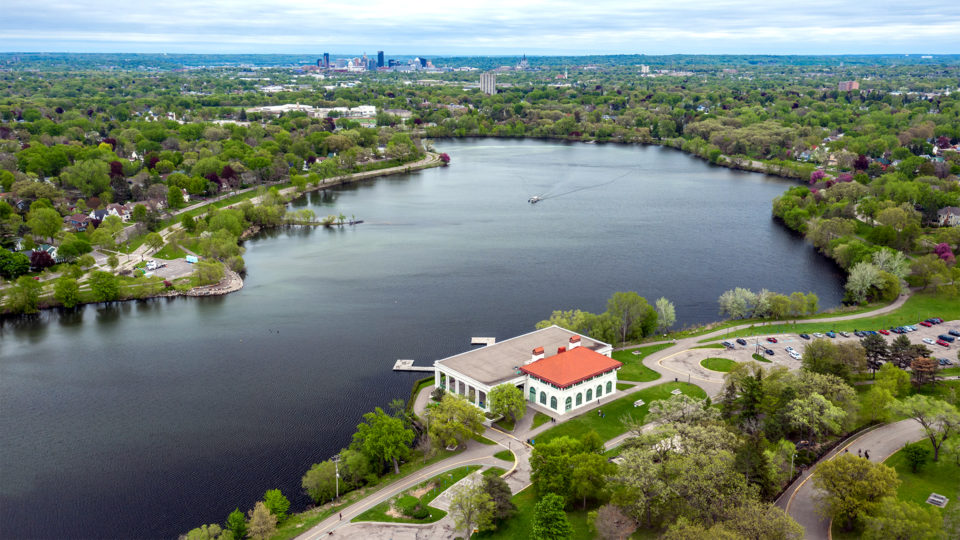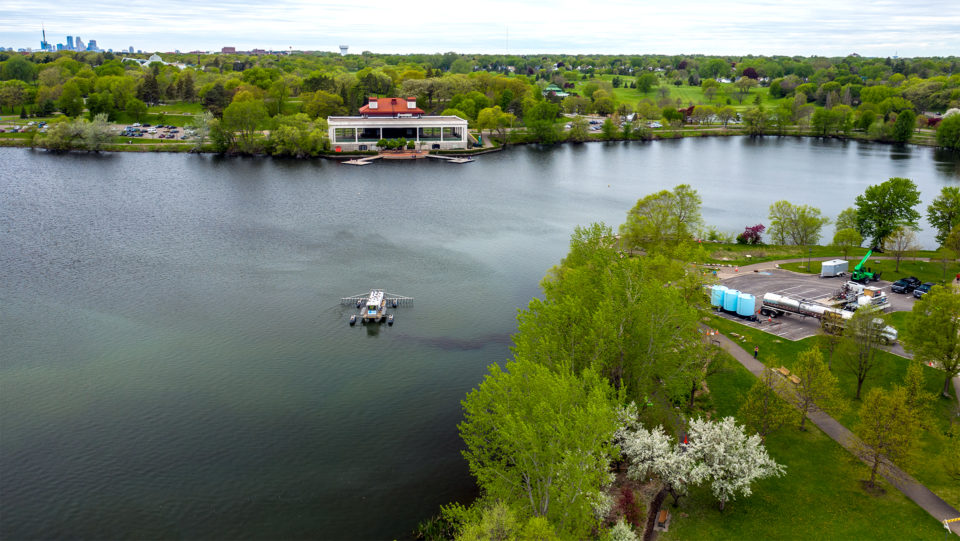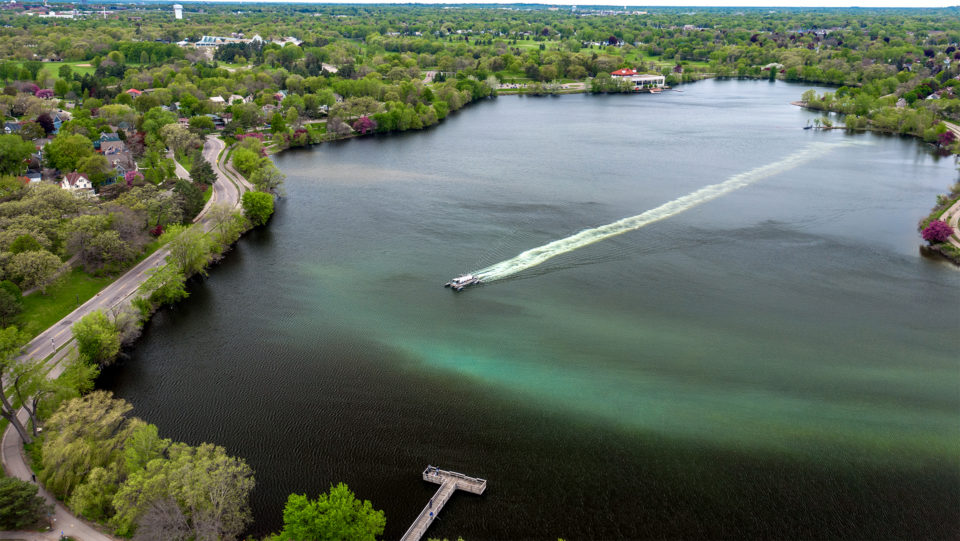Landmark Improvements in Como Lake’s Water Quality
In 2020, Como Lake nearly met the state standard for phosphorous for the first time on record! Capitol Region Watershed District (CRWD) has been working to improve the lake’s water quality for over 20 years and two recent projects helped bring us within reach of achieving our water quality goals. This means fewer algae blooms, less odor, better wildlife habitat, and an overall ecologically healthier Como Lake.
Issues Affecting Water Quality
Como Lake has a long history of poor water quality that is largely due to excess phosphorus in the lake. Phosphorus comes from leaves, grass clippings, pet waste, and soil that is carried to the lake in stormwater runoff. Over time, phosphorus has built up in the lake — reaching levels as high as three-times the Minnesota state standard — causing algae blooms, fish kills, and strong odors mid-summer.
Also problematic to Como Lake’s water quality is the invasive aquatic plant Curly-Leaf Pondweed (CLP) that dominates the lake’s ecosystem. Its unique life cycle allows CLP to thrive in Como Lake, making it difficult for native plants to grow. Decaying CLP also adds phosphorus to the water when it dies off mid-summer, causing more problems for Como Lake’s water quality.
Solutions
With the help of the community and agency partners, CRWD developed the Como Lake Management Plan (CLMP) in 2019 to define an approach for reducing phosphorus, improving water quality, and supporting ecological health in the lake over the next 20 years. In 2020, CRWD completed three projects recommended in the CLMP that helped significantly reduce phosphorus in Como Lake, including:
- Herbicide Treatment of Curly-Leaf Pondweed (April 2020)
- Alum Treatment of In-Lake Phosphorus (May 2020)
- Como Golf Course Project (July 2020)
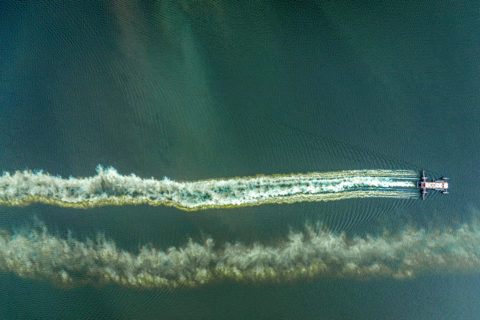
Since beginning in 1998, CRWD has completed over 75 projects to reduce phosphorous flowing into Como Lake from the surrounding neighborhoods. These projects represent a 20% reduction in phosphorous and were critical to the improvements in water quality we are seeing today. Some examples include:
Monitoring Results
Monitoring data is critical for understanding Como Lake’s complex dynamics and addressing water quality issues using a science-based approach. Data collection helps us understand and document the impacts of a project like the alum treatment on Como Lake’s water quality. To do this, CRWD partners with Ramsey County and the Minnesota Department of Natural Resources to monitor Como Lake for a variety of water quality and biological parameters.
Data was collected throughout 2020 to observe Como Lake’s response to the projects completed last year. While the 2020 data only represents the first year following project implementation, CRWD’s analysis shows very positive results!
Decrease in Phosphorus Levels
During the 2020 monitoring season, annual average concentrations of total phosphorus (TP) in Como Lake significantly decreased to 65 µg/L, the lowest level recorded in Como Lake’s history and just shy of the state standard of <60 µg/L. Historically, annual TP concentrations have averaged at 173 µg/L, so the changes observed in 2020 represent a dramatic improvement from previous conditions.
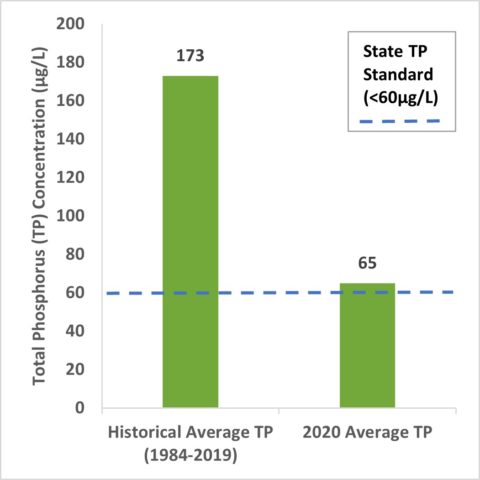
Dissolved phosphorous is another important measurement of lake water quality because it’s consumed by algae which causes the lake to become green in the summertime. CRWD conducted an alum treatment last spring to target dissolved phosphorus in the lake bottom. An 87% decrease in dissolved phosphorus was observed in 2020 in comparison to historical concentrations. This result proves that the alum treatment worked and did a great job of preventing internal phosphorus loading.
Reductions in Curly-Leaf Pondweed
Curly-Leaf Pondweed (CLP) was significantly reduced after the April 2020 herbicide treatment. The number of plants decreased by 56% in 2020 in comparison to the plants observed in 2019. The treatment was done immediately after ice-off to protect the native plant community, which begins growing later in the season. The early-season treatment also prevented CLP plants from maturing any further since they begin growing beneath the ice. The 56% decrease in CLP in 2020 represents significant progress towards getting populations under control so native plants can begin to establish. Native plants are important because they help stabilize the sediment and provide habitat for aquatic life such as fish.
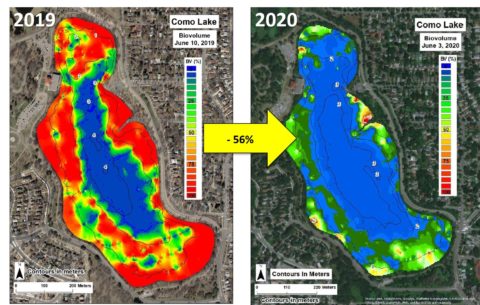
Further evidence of the herbicide treatment’s success was revealed in September 2020 following a survey of the turions, or the reproductive buds produced by CLP plants. Each plant can produce up to 100 turions that fall off and help grow new plants. Survey results showed a 79% decrease in turions in 2020 in comparison to a survey completed in 2019. This result also means that fewer plants will come back in 2021 since the CLP seedbank was drastically reduced.
The plant survey data also showed that native plants were slow to rebound in 2020, likely due to decades of seedbank loss from the CLP infestation. It is expected that native plants will begin to return to Como Lake in the coming years as progress is made toward CLP control and improved water clarity.
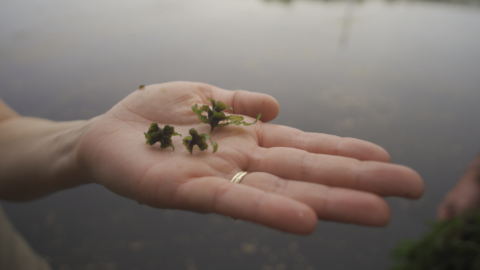
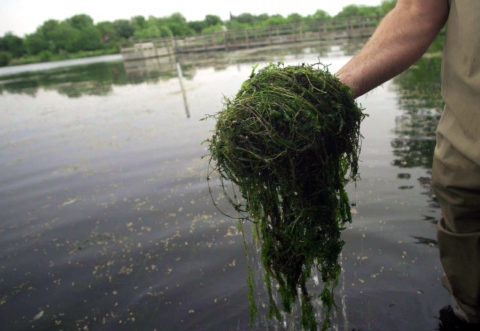
What’s Next?
On Wednesday, March 31, 2021 the herbicide Fluridone was applied to Como Lake to target curly-leaf pondweed, an invasive aquatic plant. It was applied from a boat by a licensed contractor to the whole lake at a low concentration of 4 parts per billion and will be maintained for 60 days. Additional applications may be necessary during the 60-day period to maintain the concentration level.
Signs will be posted around the lake during treatment to notify visitors. There are no contact restrictions with Fluridone, so visitors, pets, and wildlife do not need to avoid the water during the application. Monitoring will occur throughout the treatment and the months following to maintain safe concentrations and to determine its effectiveness.
What is Fluridone? Fluridone is an herbicide that stops plants from making food (photosynthesis), causing them to die off within 2 months of the treatment. Fluridone is only effective for plants that are growing at the time of treatment. Curly-leaf pondweed begins growing in late fall and continues growing under the ice during the winter. With application in late March the herbicide will target curly-leaf pondweed since native aquatic plants haven’t started their growing season.
CRWD will continue working toward the goals of the Como Lake Management Plan. Project plans in 2021 include the additional herbicide treatment outlined above, shoreline maintenance, fish surveys, and stormwater runoff management.
Further improvements are expected as Como Lake settles into a new equilibrium and additional projects help reduce phosphorus. CRWD will continue monitoring to further understand the effects of these treatments as well as other major phosphorus reduction efforts, like the Como Golf Course projects.
Learn how you can help protect Como Lake at captiolregionwd.org/act-now/
For more information on Como Lake:
- Como Lake page
- Recording of the Como Lake Community Update Meeting on March 11, 2021
- 2020 Como Lake Water Quality Summary PDF

